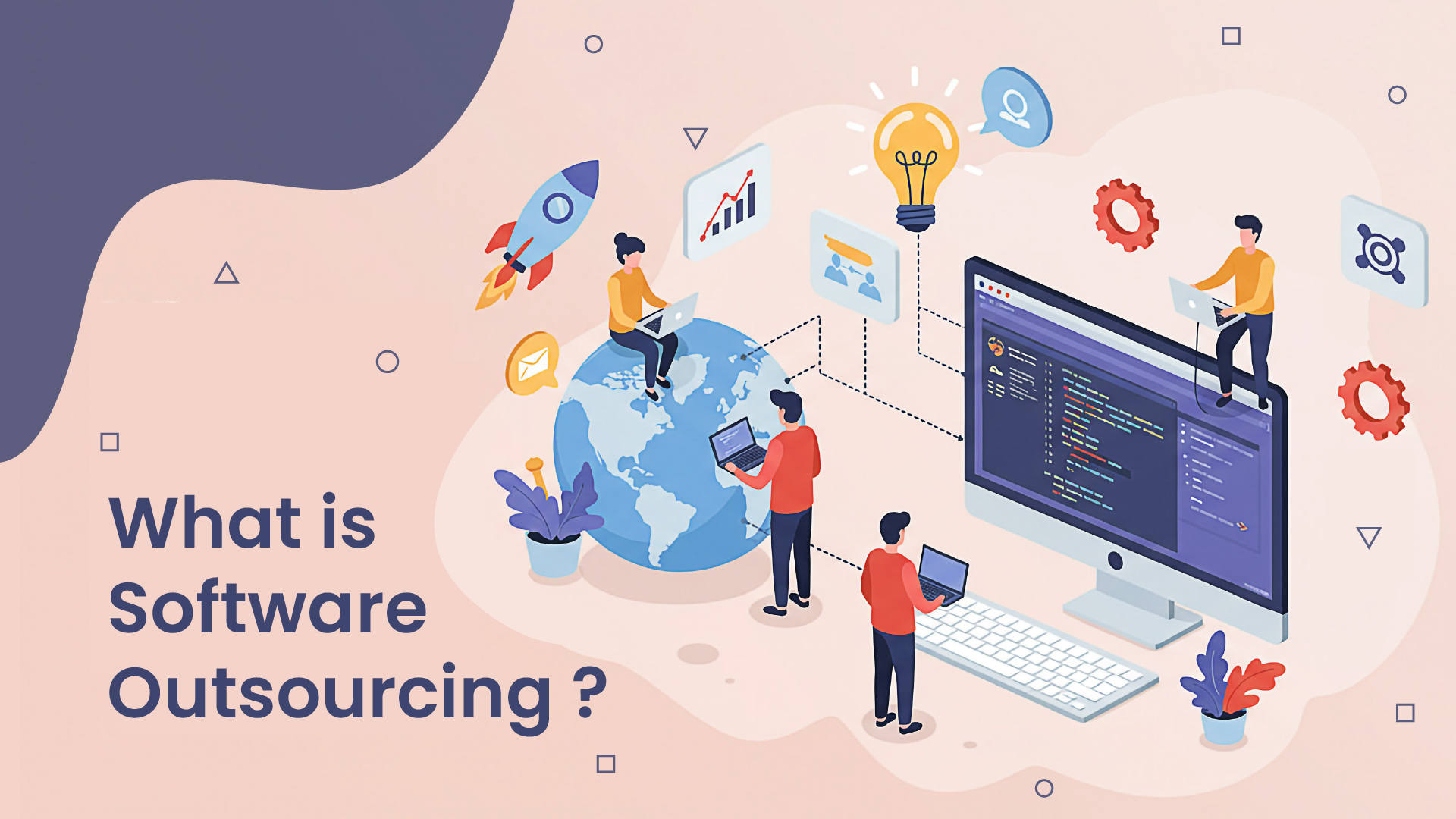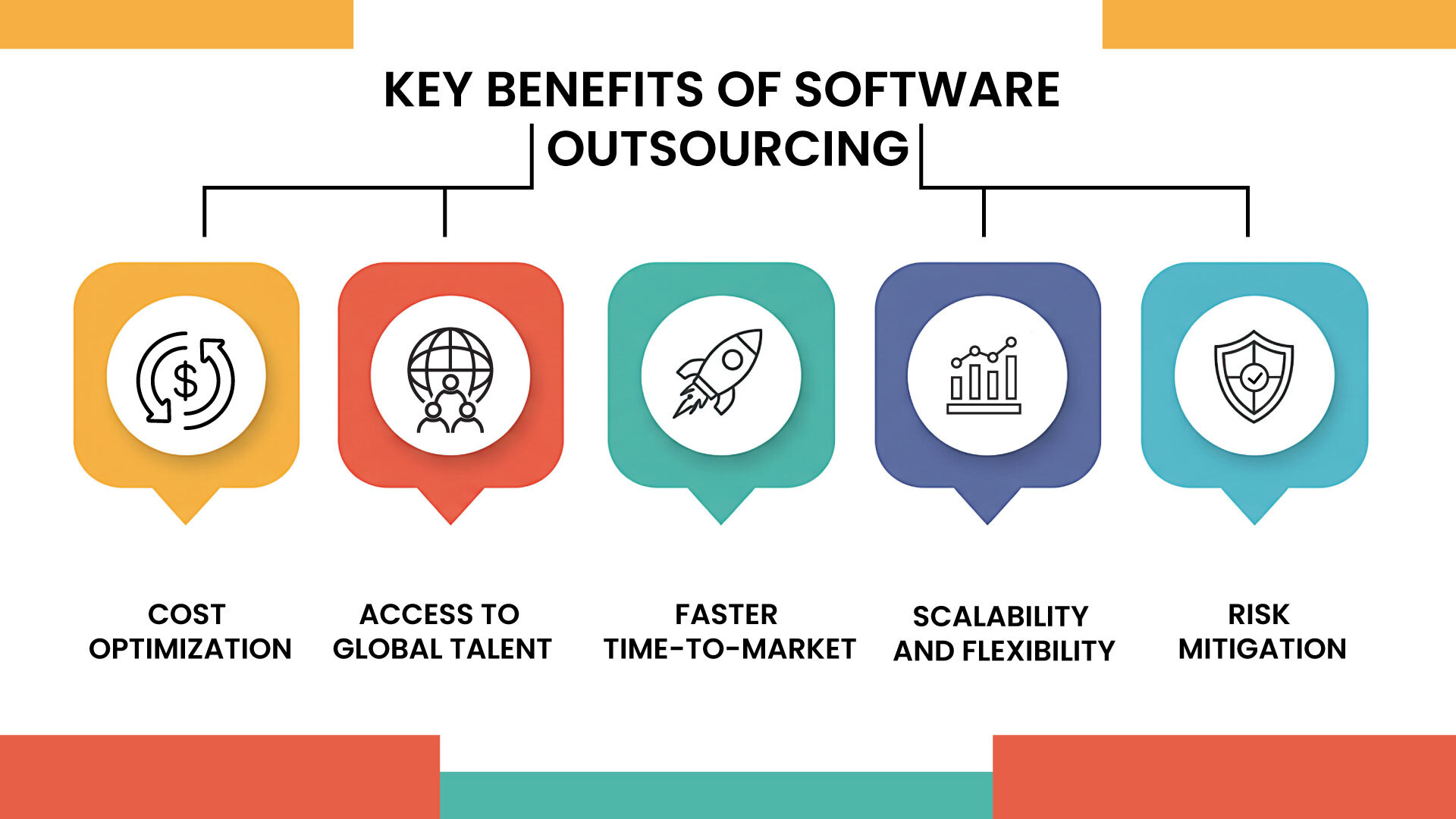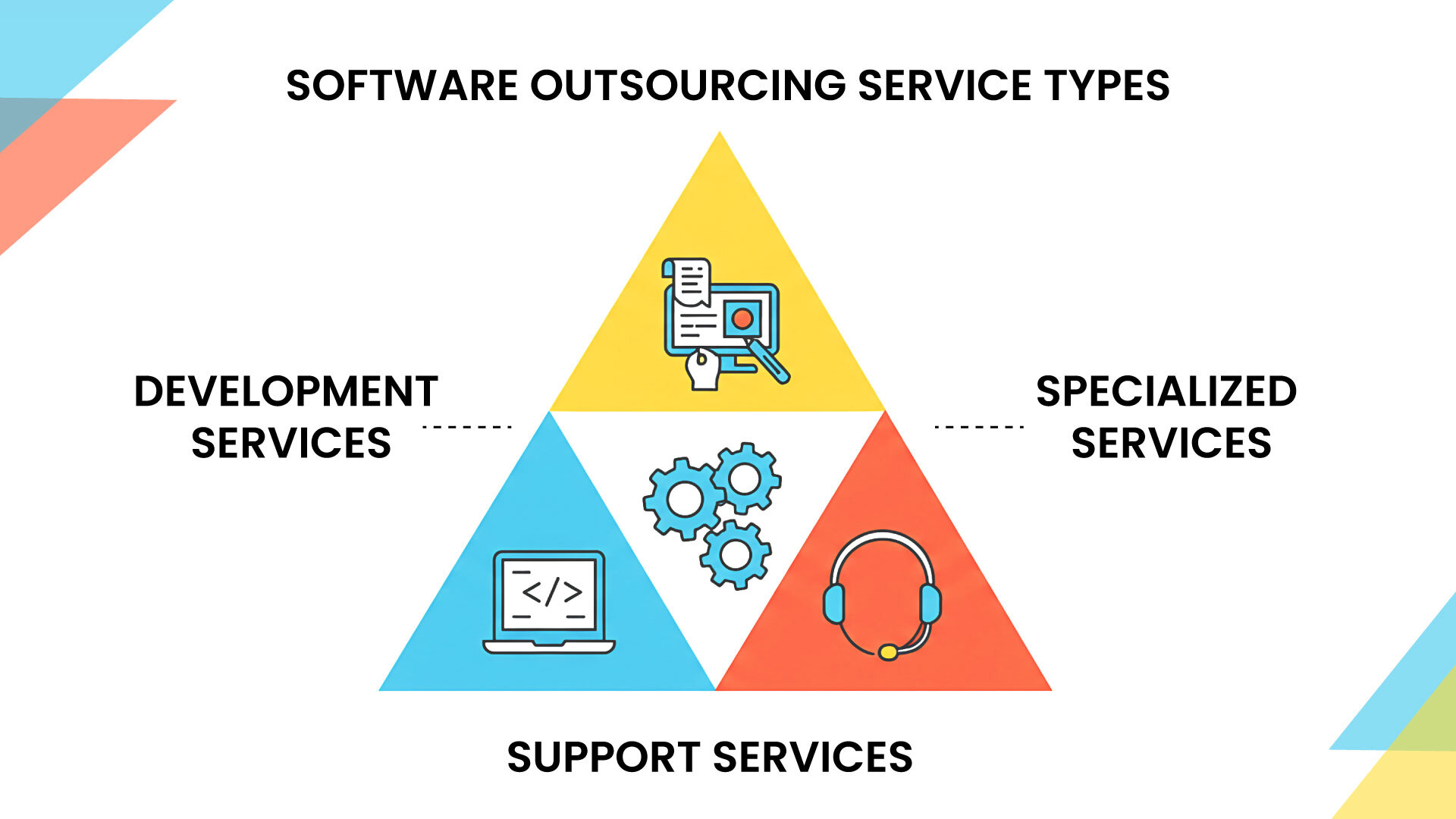Introduction
Did you know that by the end of 2024, the IT outsourcing market will be worth about $512.5 billion? This mind-blowing number is more than just numbers; it shows that businesses worldwide are changing how they make software and find tech solutions.
You’re not alone if you’re a business leader dealing with rising development costs, a lack of skilled workers, or the need to grow quickly. Companies all over the world are learning that outsourcing software isn’t just a way to save money; it’s also a way to get access to a global pool of talent, speed up project timelines, and let experts handle the technical heavy lifting while they focus on their core business activities.
This complete guide will cover everything you need to know about outsourcing software, from learning about the different models to picking the best partner for your business needs. It will give you the information you need to make wise choices, whether thinking about your first outsourcing project or trying to improve your current strategy.
What is Software Outsourcing?

Companies that use software outsourcing give tasks like software development, IT services, or technology projects to outside companies. Instead of hiring developers or building IT teams inside the company, businesses work with specialized companies that have the knowledge, tools, and infrastructure to provide high-quality software solutions.
This strategic approach lets businesses:
- Get specialized skills and technologies
- Cut down on overhead and operational costs
- Quickly grow development teams
- Concentrate on your main business tasks
- Speed up the time it takes for products to get to market
The Changes in Software Outsourcing
Software outsourcing has evolved significantly from simple cost-cutting measures to strategic partnerships. Modern outsourcing encompasses everything from mobile app development and web applications to complex enterprise software solutions, AI integration, and digital transformation initiatives.
Types of Software Outsourcing Models
Understanding different outsourcing models is crucial for making the right choice for your business. Here are the three primary approaches:
1. Offshore Outsourcing
This model offers cost savings, access to a global talent pool, and flexibility in scaling teams according to project needs. Offshore outsourcing involves partnering with development teams in distant countries, typically with significant time zone differences.
Key Benefits:
- Cost Efficiency: Up to 60-70% cost reduction compared to domestic hiring
- Global Talent Access: Tap into specialized skills worldwide
- 24/7 Development: Time zone differences enable round-the-clock progress
- Scalability: Easily expand or reduce team size
Considerations:
- Communication challenges due to time zones
- Cultural and language barriers
- Potential security concerns
- Quality control complexities
Popular Offshore Destinations:
- India (software development, IT services)
- Ukraine (web development, mobile apps)
- Philippines (customer support, testing)
- Vietnam (emerging tech hub)
2. Nearshore Outsourcing
Nearshore outsourcing typically falls between onshore and offshore costs. While it may be slightly more expensive than offshoring, nearshore teams often offer better communication and cultural alignment.
Key Benefits:
- Cultural Alignment: Similar business practices and work ethics
- Time Zone Compatibility: 1-3 hour difference maximum
- Cost Savings: 30-50% reduction compared to onshore
- Easy Communication: Minimal language barriers
Considerations:
- Higher costs than offshore options
- Limited talent pool compared to global offshore markets
- Regional economic factors may affect pricing
Popular Nearshore Destinations for US Companies:
- Mexico (growing tech sector)
- Canada (high-quality development)
- Costa Rica (stable infrastructure)
- Argentina (strong in fintech)
3. Onshore Outsourcing
Onshore outsourcing offers cultural familiarity, reducing potential misunderstandings. Working within the same time zone makes communication smoother and more immediate.
Key Benefits:
- No Communication Barriers: Same language and culture
- Easy Collaboration: Same time zone and business hours
- Legal Compliance: Uniform regulations and laws
- Quality Assurance: Easier oversight and control
Considerations:
- Highest cost option (10-20% savings compared to in-house)
- Limited cost advantages
- It may not solve talent shortage issues
Key Benefits of Software Outsourcing

1. Cost Optimization
Outsourcing can save up to 40% by allowing businesses to tap into a global talent pool of over 500,000 specialized developers. Includes:
- Reduced Labor Costs: Access to competitive global rates
- Infrastructure Savings: No need for office space, equipment, or software licenses
- Training Cost Elimination: Outsourcing partners provide trained professionals
- Reduced Overhead: Lower management and administrative costs
2. Access to Global Talent
The global software development market provides access to:
- Specialized expertise in emerging technologies (AI, blockchain, IoT)
- Experienced developers in niche platforms and frameworks
- Certified professionals in specific industries (healthcare, fintech, e-commerce)
- Multilingual teams for international projects
3. Faster Time-to-Market
Accelerating time-to-market by up to 50% through:
- Dedicated Teams: Focus exclusively on your project
- Proven Processes: Established development methodologies
- Parallel Development: Multiple teams working simultaneously
- 24/7 Progress: Round-the-clock development cycles
4. Scalability and Flexibility
Outsourcing provides:
- Rapid Team Scaling: Add or reduce team members quickly
- Project-Based Engagement: Scale based on project requirements
- Technology Flexibility: Access to the latest tools and technologies
- Resource Optimization: Allocate resources where needed most
5. Risk Mitigation
- Technology Risk: Partners stay updated with the latest technologies
- Talent Risk: Reduced dependency on individual employees
- Operational Risk: Distributed development across multiple locations
- Compliance Risk: Partners handle regulatory requirements
Software Outsourcing Service Types

Development Services
- Custom Software Development: Tailored applications for specific business needs
- Web Application Development: Responsive, scalable web solutions
- Mobile App Development: Native and cross-platform mobile applications
- Enterprise Software: ERP, CRM, and business management systems
Specialized Services
- AI and Machine Learning: Intelligent automation and data analysis
- Cloud Migration: Moving applications to cloud platforms
- DevOps Implementation: Continuous integration and deployment
- Quality Assurance: Comprehensive testing and quality control
Support Services
- Maintenance and Support: Ongoing application updates and bug fixes
- Legacy System Modernization: Updating outdated systems
- Technical Consulting: Strategic technology guidance
- Staff Augmentation: Temporary team expansion
Cost Analysis: Outsourcing vs In-House Development
| Factor | In-House Development | Offshore Outsourcing | Nearshore Outsourcing | Onshore Outsourcing |
| Average Hourly Rate | $80-150 | $20-50 | $35-75 | $70-130 |
| Setup Time | 3-6 months | 1-2 months | 1-3 months | 2-4 months |
| Infrastructure Costs | High | None | None | Low |
| Management Overhead | High | Medium | Low | Low |
| Total Cost Savings | Baseline | 60-70% | 30-50% | 10-20% |
| Communication Ease | Excellent | Challenging | Good | Excellent |
| Time Zone Alignment | Perfect | Difficult | Good | Perfect |
How to Choose the Right Outsourcing Partner
1. Define Your Requirements
Before starting your search:
- Project Scope: Clearly outline features, functionality, and timeline
- Budget Range: Establish realistic budget expectations
- Technology Stack: Specify required programming languages and platforms
- Team Size: Determine how many developers you need
- Communication Preferences: Define meeting schedules and communication channels
2. Research and Evaluation Criteria
Technical Expertise
- Portfolio of similar projects
- Certifications and technical skills
- Experience in your industry
- Knowledge of the latest technologies
Business Stability
- Company history and financial stability
- Client testimonials and case studies
- Team size and retention rates
- Process maturity and methodologies
Communication and Culture
- English proficiency levels
- Cultural alignment with your business
- Time zone compatibility
- Project management approaches
3. Due Diligence Process
Initial Screening
- RFP (Request for Proposal): Send detailed project requirements
- Technical Assessment: Evaluate technical capabilities
- Reference Checks: Contact previous clients
- Security Audit: Review data protection measures
Detailed Evaluation
- Pilot Project: Start with a small project to test capabilities
- Team Interviews: Meet key team members
- Process Review: Understand development methodologies
- Contract Negotiation: Define terms, timelines, and deliverables
Best Practices for Successful Software Outsourcing
1. Establish Clear Communication Protocols
- Regular Meetings: Schedule daily standups and weekly progress reviews
- Communication Tools: Use Slack, Microsoft Teams, or similar platforms
- Documentation: Maintain detailed project documentation
- Feedback Loops: Create structured feedback mechanisms
2. Implement Strong Project Management
- Agile Methodology: Use Scrum or Kanban for iterative development
- Project Tracking: Utilize tools like Jira, Trello, or Asana
- Milestone Definition: Set clear deliverables and deadlines
- Quality Gates: Implement regular code reviews and testing phases
3. Ensure Data Security and Compliance
- NDA (Non-Disclosure Agreement): Protect intellectual property
- Data Encryption: Secure data transmission and storage
- Compliance Requirements: Ensure adherence to industry regulations
- Access Controls: Implement proper user access management
4. Build Long-Term Relationships
- Cultural Integration: Invest time in understanding partner culture
- Team Bonding: Organize virtual or in-person team meetings
- Continuous Improvement: Regular retrospectives and process optimization
- Partnership Development: Treat outsourcing partners as strategic allies
Common Challenges and Solutions
Challenge 1: Communication Barriers
Solutions:
- Establish clear communication protocols from day one
- Use visual communication tools (screenshots, mockups, videos)
- Provide cultural training for both teams
- Designate dedicated points of contact
Challenge 2: Quality Control Issues
Solutions:
- Implement comprehensive testing procedures
- Set up regular code review processes
- Define clear acceptance criteria
- Use automated testing tools
Challenge 3: Time Zone Management
Solutions:
- Plan overlapping working hours for critical discussions
- Use asynchronous communication effectively
- Document all decisions and changes
- Create detailed handoff procedures
Challenge 4: Scope Creep and Change Management
Solutions:
- Define detailed project requirements upfront
- Implement formal change request processes
- Use agile methodologies for flexibility
- Regular scope review meetings
The Future of Software Outsourcing
Emerging Trends
1. AI-Powered Development
Generative AI: It’s an AI that creates code and accelerates development processes. AI tools are revolutionizing how outsourced teams approach:
- Code generation and optimization
- Automated testing procedures
- Bug detection and resolution
- Project estimation accuracy
2. Cloud-First Approach
- Infrastructure as Code: Automated cloud deployments
- Microservices Architecture: Scalable, maintainable applications
- Serverless Computing: Cost-effective, scalable solutions
- Multi-Cloud Strategies: Avoiding vendor lock-in
3. Security-First Development
- DevSecOps Integration: Security built into development processes
- Zero Trust Architecture: Enhanced security protocols
- Compliance Automation: Automated regulatory compliance
- Privacy by Design: Built-in data protection measures
Market Projections
The IT Outsourcing market worldwide is projected to grow by 8.28% (2025-2029), resulting in a market volume of US$812.70bn in 2029. This growth indicates:
- Increased adoption across industries
- Evolution toward strategic partnerships
- Focus on specialized expertise
- Integration of emerging technologies
How Desol Int Can Help Your Outsourcing Journey
As you consider software outsourcing for your business, partnering with an experienced provider can make all the difference. Desol Int offers comprehensive software development services that combine technical expertise with strategic business understanding.
Our team specializes in:
- Custom Software Development: Tailored solutions for unique business requirements
- Web Application Development: Scalable, responsive web solutions
- Mobile App Development: Cross-platform and native mobile applications
- Digital Transformation: Modernizing legacy systems and processes
What sets Desol Int apart is our commitment to transparent communication, agile development practices, and long-term partnerships. We understand that outsourcing is not just about code, it’s about building solutions that drive business growth and innovation.
Conclusion
Software outsourcing has evolved from a cost-cutting strategy to a powerful business enabler that provides access to global talent, accelerates innovation, and drives competitive advantage. Whether you choose offshore, nearshore, or onshore outsourcing, success depends on careful planning, partner selection, and ongoing relationship management.
The key to successful outsourcing lies in:
- Understanding your specific business needs and objectives
- Choosing the right outsourcing model for your situation
- Selecting partners based on expertise, not just cost
- Implementing strong communication and project management practices
- Building long-term strategic relationships
As the market continues to grow and evolve, businesses that embrace software outsourcing strategically will be better positioned to innovate, scale, and compete in the digital economy.
Ready to explore software outsourcing for your business? Contact Desol Int today to discuss how our expert development team can help accelerate your projects while optimizing costs and ensuring quality deliverables.
Frequently Asked Questions (FAQs)
What is the difference between software outsourcing and staff augmentation?
Software outsourcing involves delegating entire projects or functions to external providers who manage the complete development process, from planning to delivery. Staff augmentation, on the other hand, involves hiring external developers to work alongside your internal team under your direct management. Outsourcing provides end-to-end project management, while staff augmentation supplements your existing team capacity.
How much can I save with software outsourcing?
Cost savings vary significantly based on the outsourcing model chosen. Offshore outsourcing can provide 60-70% cost reduction, nearshore outsourcing offers 30-50% savings, while onshore outsourcing typically saves 10-20% compared to in-house development. However, actual savings depend on project complexity, duration, and the specific partner selected.
How do I ensure quality when outsourcing software development?
Quality assurance requires implementing robust processes, including detailed requirement documentation, regular code reviews, automated testing procedures, clear acceptance criteria, and milestone-based deliverables. Choose partners with proven track records, relevant certifications, and strong portfolio examples. Consider starting with a pilot project to evaluate capabilities before committing to larger engagements.
What are the biggest risks in software outsourcing, and how can I mitigate them?
Common risks include communication barriers, quality control issues, intellectual property concerns, and dependency on external providers. Mitigate these risks by establishing clear contracts with IP protection clauses, implementing strong communication protocols, conducting regular quality assessments, and maintaining some internal technical knowledge to oversee outsourced work effectively.
How long does it typically take to set up an outsourcing relationship?
The setup timeline varies by outsourcing model and project complexity. Offshore arrangements typically require 1-2 months for partner selection, team assembly, and project initiation. Nearshore setups usually take 1-3 months, while onshore arrangements may require 2-4 months. Factor in time for due diligence, contract negotiations, team introductions, and initial project planning phases.